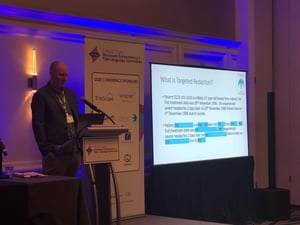The 7th annual Clinical Data Disclosure, Transparency & Plain Language Summaries conference kicked off in Miami Florida with three in-depth tracks to gain knowledge and insight from. The first day featured a keynote address from Jessica Scott, the Head of Patient Engagement at Takeda. “At the core of trust is transparency” she stated, as she rallied for “Transparency 2020”, a patient and industry partnership that builds trust and uses the insight from patients to reduce the burden of clinical trials. It was an inspiring beginning to a conference that focused on patient trust.
Updates from other recent industry conferences were shared, along with a strong overview of Health Canada’s Public Release of Clinical Information regulation (presented by Melissa Jean, Health Canada). During a question and answer portion of the Health Canada update, Melissa acknowledged there has been some back and forth with sponsors around certain redactions they do not feel are warranted and they have strongly urged some sponsors to change their approach. She made it clear that Health Canada is available and willing to discuss any questions sponsors may have and despite pushback on certain redactions, no redactions have been removed by Health Canada without the sponsor’s consent, even though they reserve the right to do so. Our very own transparency and disclosure expert, Cathal Gallagher, asked who would bare the risk in the event of a data breach and for that, there was no clear answer. She stated they “hope” that won’t happen so it’s occurrence may be the only time we get a clear answer to that question. The consensus from attendees who have worked on a submission already was that Health Canada has been inconsistent with their feedback and the tight timelines have been difficult to manage, with the average posting time at 127 days. Melissa stated the goal is to publish within 120 days and there is no formal extension process, however, they are willing to work with sponsors on larger packages.
Track A: Clinical Disclosure & Anonymization
 Once the three different tracks started, we took a deep dive into learning. The first track was on clinical disclosure and anonymization. We learned about achieving balance with a quantified risk approach (presented by Cathal Gallagher, d-wise) and the difference between redaction and more advanced methods of anonymization. Health Canada said they have no plans at this time to enforce these methods but Cathal showed us the benefits of using them and the higher level of data utility they provide.
Once the three different tracks started, we took a deep dive into learning. The first track was on clinical disclosure and anonymization. We learned about achieving balance with a quantified risk approach (presented by Cathal Gallagher, d-wise) and the difference between redaction and more advanced methods of anonymization. Health Canada said they have no plans at this time to enforce these methods but Cathal showed us the benefits of using them and the higher level of data utility they provide.
Track B: Plain Language Summaries & Dissemination Strategies
The plain language summaries track focused on best practices, new technology, and writing with the patient in mind, not just the baseline requirements. “The more we build on patient engagement, the more we can integrate the feedback into transparency and disclosure and the better things will be for the patient and the sponsor,” said Behtash Bahador from CISCRP.
Track C: Regulatory & Medical Writing
The regulatory and medical writing track focused on writing with transparency and the end-user in mind. Jo Anne-Marie Blyskal from Teva pointed out that key documents are no longer written for regulatory approval only, they are now written with publication in mind, which is a major shift from five years ago.
The second day of the conference focused on patient perspectives, patient engagement, and partnering with patients so the trustworthiness of the pharmaceutical industry rises. A working group session on the global harmonization of clinical trial transparency requirements (presented by Julie Holtzople from AstraZeneca and Nate Root from Ionis Pharmaceuticals) had everyone on their feet and sharing ideas. It was this level of passion and interest that many stakeholders hope to see continue after the conference in order to move opportunities forward and ease certain challenges.
Day three brought everything together with several technical presentations that discussed disclosure challenges and best practices for facing them. Planning ahead, collaborating (internally and globally), and setting standards so there is only “one version of the truth” disclosed were common themes throughout the conference.
If you missed the event and would like more information, reach out to our transparency and disclosure experts at d-wise and we’d love to fill you in.